- James Conner has improved with age: Conner’s best season by PFF rush grade was in 2024, while his second-best season was in 2023.
- How long can he hold off Trey Benson?: Benson was drafted in the third round in 2024 and ended up not being a threat to Conner in his first year, but that could change this year.
- Subscribe to PFF+: Get access to player grades, PFF Premium Stats, fantasy football rankings, all of the PFF fantasy draft research tools and more!
Estimated Reading Time: 5 minutes

PFF’s Fantasy Football Player Profile series delivers the most in-depth fantasy football analysis available for the 2025 season.
Using PFF’s exclusive data, we evaluate player performance, competition for touches and how teammates and coaching staffs will impact each player’s fantasy football outlook.
Last updated: 7:15 a.m. Sunday, May 18
Player performance
James Conner was drafted by the Pittsburgh Steelers in 2017, and he played fine enough over four years, including three as a starter. He was RB7 in fantasy points per game in his first year but declined in each of the following two. He moved on to the Arizona Cardinals in 2021 and spent one year sharing the backfield with Chase Edmonds. While Edmonds was typically the starter, Conner scored 15 touchdowns, leading to his second season as a top-10 fantasy running back in points per game.
In his second season with the Cardinals, the team moved on from Edmunds, allowing Conner to start. He’s been a top-14 fantasy running back in each of the last three following seasons as Arizona’s clear lead running back. Conner’s main problem has been injuries. In his first seven seasons, he played between 10 to 15 games each season. This means while he’s been a borderline RB1 by per-game stats, he’s more of a mid-RB2 by total points per game.
While Conner was a good running back with a lot of volume over most of his career, his play has stepped up considerably over the last two seasons. He’s broken more tackles, leading to more long runs, making him a more well-rounded player. Over the last two seasons, he ranks second among running backs in rushing avoided tackles per game (4.5), rushing avoided tackles per attempt (0.297) and yards after contact per attempt (3.6).
Projected role
Conner’s role in the last two seasons has been relatively consistent the last two seasons, and we should expect more of the same this season. The Cardinals spent a third-round pick on Trey Benson in 2024 to be the Cardinals’ running back of the future. Conner had his most injury-free season last year, only missing the final game of the season, and Benson was injured a few weeks prior and wasn’t able to start.
While Benson played well enough in his limited snaps, as long as Conner is playing at his normal quality of play, it wouldn’t make sense for Conner to lose any more playing time than usual. However, Conner is over 30 years old, so if his play starts to take a step back, we could see Benson take some of Conner’s opportunities.
Conner hasn’t been playing on third downs, and that is also not where we expect Benson to play. Arizona has Emari Demercado as the main third-down back in addition to DeeJay Dallas and Michael Carter, who have both primarily played on third downs in recent years.
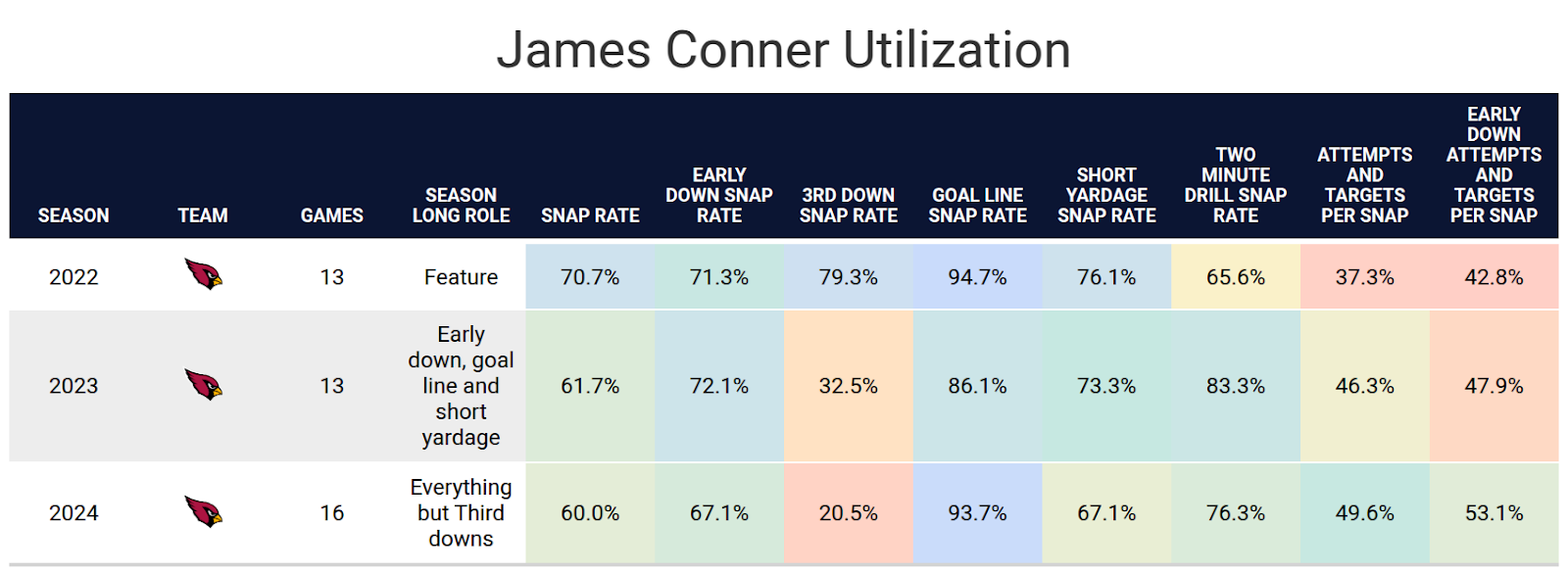
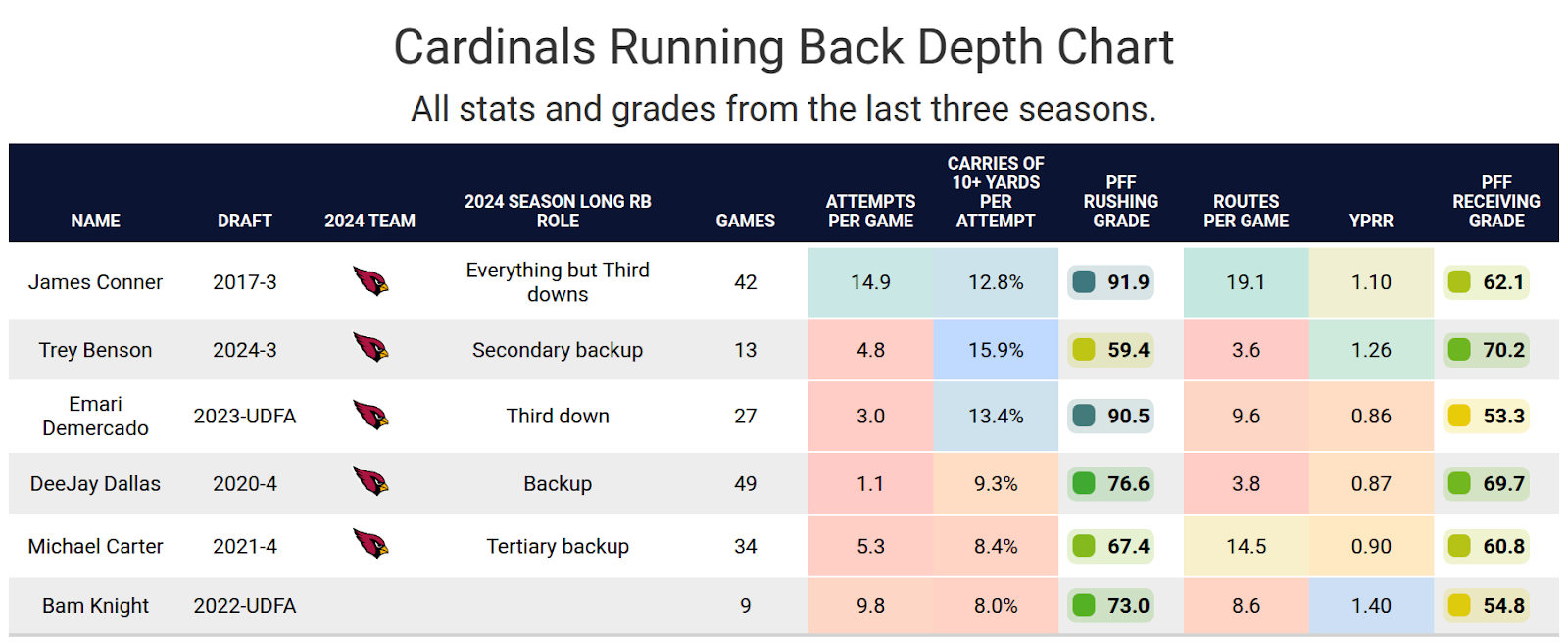
Impact of teammates
Conner will be in his third season with Drew Petzing as offensive coordinator. Pertzing taking over led to Conner starting to play less often on third downs. Last season, the team became more balanced with a healthy Kyler Murray, the Marvin Harrison Jr. addition and strong play from Trey McBride. Arizona spent the entire offseason focusing on improving its defense while keeping the offense the same, so we can expect the run and pass split to look similar to last season.
Arizona’s offensive line ranked 14th-best in run-blocking grade last season, and the entire group is back together. The line has generally played well at avoiding negative blocks but not very good at creating positive runs. Conner is generally good when the line isn’t perfect but not as good relative to other running backs when he does have a perfectly blocked run. This makes Conner’s pairing with this offensive line a little odd. It’s possible Conner would have more production if the line were better at positive blocks and worse at avoiding negative blocks, but it’s also what Conner has been used to in recent seasons.
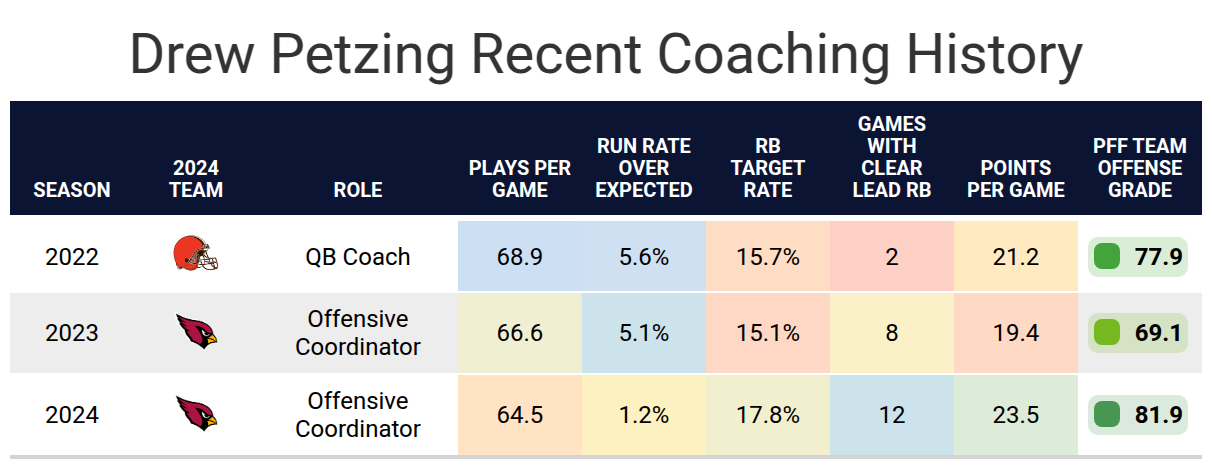
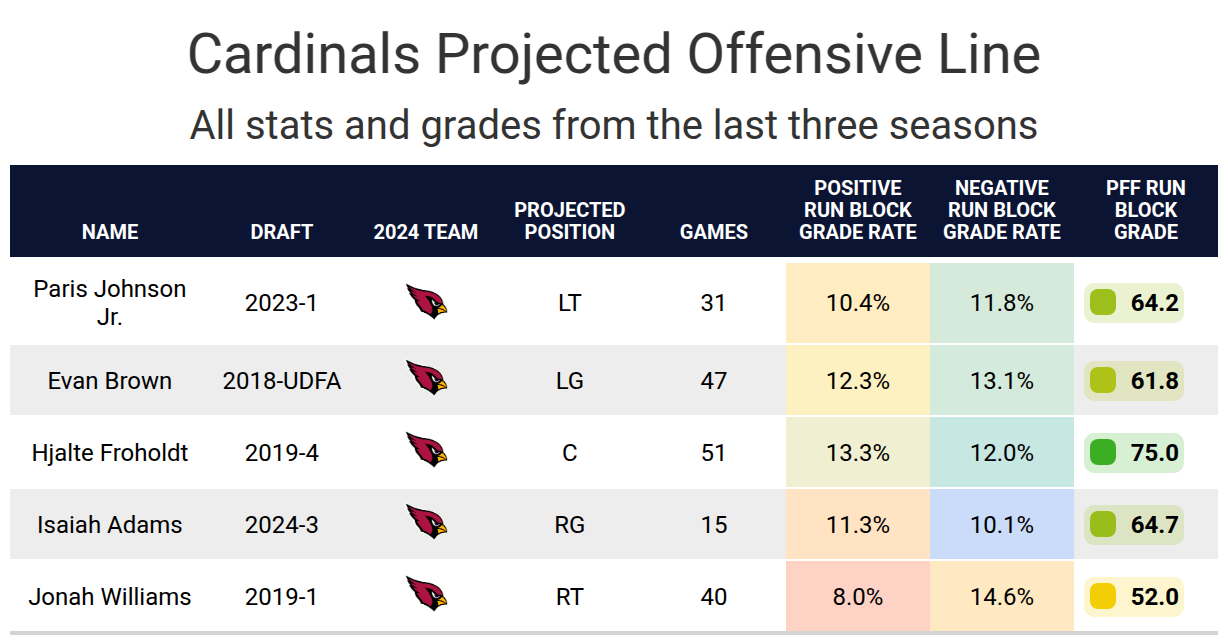
Bottom line
Conner consistently averages between 15 and 16 fantasy points per game in recent seasons when healthy. As long as he keeps playing at a high level like in recent seasons, this should be the expectation for another season. However, if his quality of play starts to dip, that could lead to Trey Benson playing more snaps, which could cause his fantasy value to quickly decline.

Footnotes
- Statistics in tables and charts were chosen based on their ability to predict future fantasy performance on a per-game or per-opportunity basis or to describe the player relative to others at the same position.
- “Opportunities” are defined as passing dropbacks, rushing attempts and routes run as a receiver.
- Numbers are provided either by season or based on the past three years. For rookies, only college statistics are included. For non-rookies, only NFL statistics are considered, regardless of whether they played in college within the previous three years.
- As college competition is easier than NFL competition, most rookies are likely to see a decline from their historical numbers.
- Only FBS data is considered for college players and comparisons.
- Kneel-downs are removed from rushing data to provide cleaner quarterback rushing rate statistics.
- The table colors in this article range from blue (indicating good/high) to red (indicating bad/low).
- All percentiles and color codings compare the given player to others with a high sample of opportunities. Generally, the cutoff is one-third of the possible opportunities in the sample. If a player does not meet the threshold, they are still included in the comparison, though their results may appear better or worse than expected due to the smaller, less predictive sample size.
- Information on utilization classifications and their importance can be found here for running backs, wide receivers and tight ends.
This news was originally published on this post .









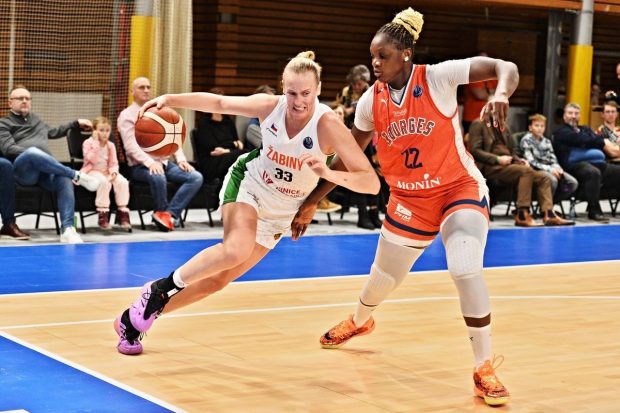
Be the first to leave a comment